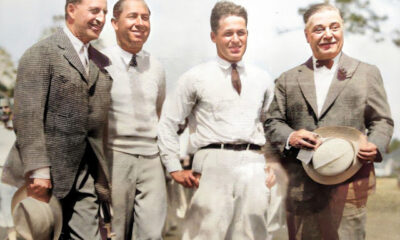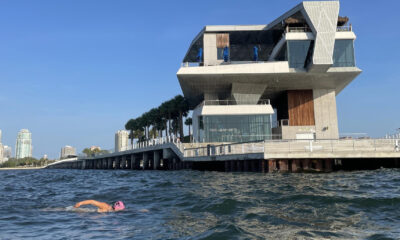Insight
Community Voices: Why St. Pete should make the pelican our official bird

Welcome to the Catalyst’s Community Voices platform. We’ve curated community leaders and thinkers from all parts of our great city to speak on issues that affect us all. Visit our Community Voices page for more details.
Sometime in 2020, I presume, St. Pete will introduce the world to its new pier. Among its anticipated delights is a statue of a giant pelican – origami style – at the top of the approach. A picture of that sculpture reminded me of a poem that is now more than 100 years old, a limerick, written by a Tennessee editor, Dixon Merritt. He was inspired to write it after he received a pelican postcard from one of his readers on vacation in West Florida:
A wonderful bird is the pelican
His bill will hold more than his belican.
He can keep in his beak
Food enough for a week,
But I’m damned if I see how the helican.
In two recent stories in the Times I explained my love of pelicans, the celebration of that bird in the history of our fair city, and steps everyone can take to make sure the Gulf Coast is a safe place for all seabirds. (In short, watch them with awe as they dive-bomb for fish, but DON’T FEED THEM, PEOPLE!)
I made an assumption during my research, that the pelican was the official bird of St. Petersburg. We all see the pelican on the flag or emblem of the city, marking the tops of garbage cans and the covers of storm drains. We see pelican imagery here, there, and everywhere.
Might as well call us St. Petersbird.
But Wayne Atherholt, the city’s elegant culture prince (he’s more prince than czar) could find no evidence that the city had embraced the pelican the way that the State of Florida has named the mockingbird as its feathered-friend-in-chief.
Every state has a state bird. Even though we associate the oriole with Baltimore, it has been formally chosen as the state bird of Maryland.
Most cities don’t have official birds, but St. Pete has proven that it is not like most cities. It might follow in the path of Canberra, Australia, where the official bird is the laughing kookaburra. Quito, Ecuador, has a thing for the black-breasted puffleg. Wikipedia lists 30 American cities with adopted birds, the most surprising being Madison, Wisconsin. In this college town, the city mothers and fathers must have been experiencing an “area high” when they adopted the “plastic pink flamingo” as their city bird.
Even in Florida, St. Pete appears to be behind the curve. St. Augustine has its roseate spoonbill; a flock of them in flight offers an explosion of pink in the air. Our neighbor Dunedin has built a civic nest for that great sea hawk we call the osprey. Key West has chosen the chicken, a more noble creature when designated scientifically as Gallus gallus.
I am afraid that one Texas coast town, Aransas Pass, has beaten us to the brown pelican, Pelecanus occidentalis. I learned in my research that the brown pelican almost disappeared in Texas, but has made a comeback, due in part to pelicans sent there from the Tampa Bay region. (I propose that the city send Wayne Atherholt to Aransas Pass to test for possible sister city designation.)
As I wrote in a message to St. Pete mayor Rick Kriseman: “Why not make official what is already in everyone’s minds and hearts.” Costs could be limited to the piece of paper upon which could be written a proclamation.
Here are my six reasons for making it official:
- The pelican is already ubiquitous in the iconography of the city.
- Because of its unusual appearance, the pelican lends itself to artistic representations from the visual arts to poetry.
- The pelican appears happily on postcards, T-shirts and other paraphernalia. Even if the name St. Petersburg does not appear, such merchandise creates branding for the city.
- The pelican is associated with the old pier, but not in an environmentally helpful way. Tourists took photos while feeding pelicans, an act which makes the birds lazy and vulnerable to entanglement with fishing lines. The new pier should have the health and safety of all seabirds as a top priority.
- As the city moves forward in many directions, it should not abandon its history and traditions. Pelican lore goes back more than a century in St. Petersburg, knowledge that can be revived to give tourists and newcomers a sense of why we live here.
- Pelicans are so much fun. And so is St. Pete!
Roy Peter Clark has lived in St. Petersburg since 1977. He teaches writing at the Poynter Institute. His 19th book will be published in January.








Kathleen Murphy Posey
January 6, 2020at6:46 pm
Love this idea! Almost as much as we all love pelicans. What a great way to kick off the new decade with an official proclamation adopting the pélican as our own.
Alexandra Geiger
November 27, 2019at10:16 am
I totally agree! I just moved here in October after spending 4 winters here. I assumed it was the official bird here.
I have been Hand carving pelican images on 12” x 12” architectural tiles with a vision to get them and others into all the blank walls in St Pete! Would love to have them Grace the pier!
Alexandra ……. Raven Oak Clay Works….. on Facebook!
845- 430-8701